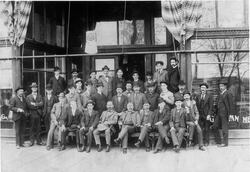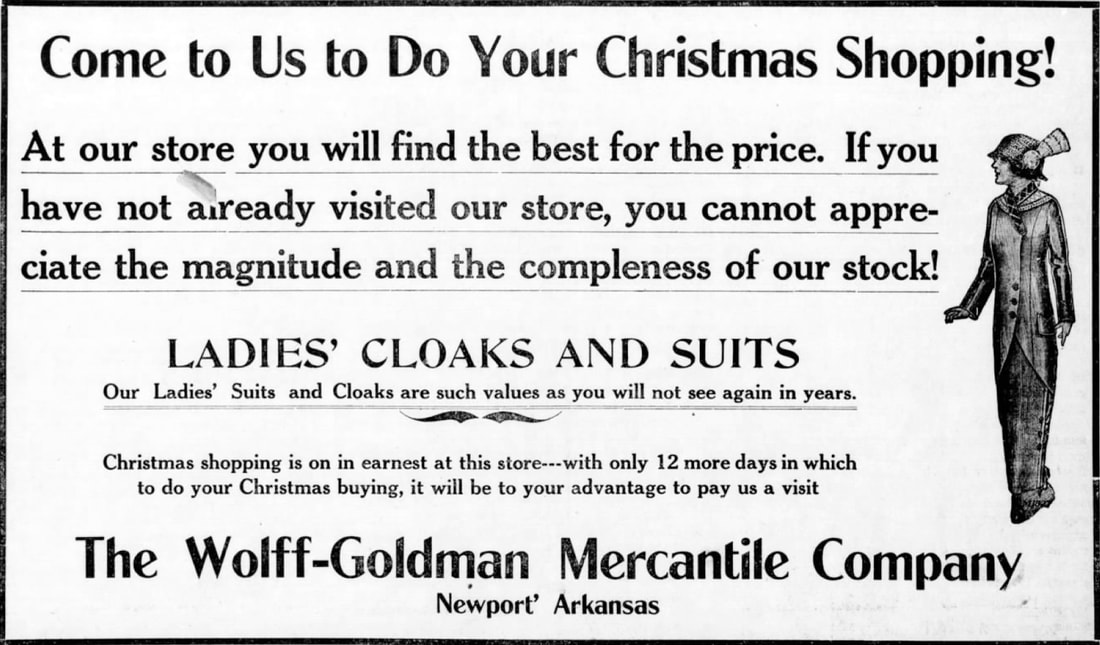Encyclopedia of Southern Jewish Communities - Newport, Arkansas
Overview
Newport developed as a riverport and rail hub following the Civil War, and it became the seat of Jackson County in 1892. The town of Jacksonport, just a few miles up the White River from Newport, had served as the original trading center in the area during the mid-19th century. When Jacksonport refused to grant a right-of-way for railroad construction in the 1850s, however, the older town set itself on the course for obsolescence. In the late 19th and early 20th centuries, Newport thrived as a small shipping center at the boundary between the Ozark foothills and the Arkansas Delta.
A handful of Jewish settlers migrated to Jackson County and neighboring areas before the Civil War, and several Jewish families made their way to Newport during its rise to prosperity. A rural settlement outside of Newport also hosted an ill-fated and short-lived Jewish agricultural colony in the 1880s. The town itself became home to a small Jewish community that briefly supported a small congregation, but Jewish organizational life never developed solid roots in Newport and the Jewish population dwindled over the course of the 20th century.
A handful of Jewish settlers migrated to Jackson County and neighboring areas before the Civil War, and several Jewish families made their way to Newport during its rise to prosperity. A rural settlement outside of Newport also hosted an ill-fated and short-lived Jewish agricultural colony in the 1880s. The town itself became home to a small Jewish community that briefly supported a small congregation, but Jewish organizational life never developed solid roots in Newport and the Jewish population dwindled over the course of the 20th century.
Early Jewish Settlers
The area around Newport began to attract Jews before the Civil War. Aaron Hirsch, whose birthplace appears in records as either Bavaria or Alsace, settled in Batesville—approximately 30 miles northwest of Newport in Independence County—in the 1850s. Hirsch left Arkansas in 1865 but returned to Jacksonport around 1875. Within the next decade he joined the exodus of Jacksonport citizens to Newport, where he operated a successful general store. In 1879 Hirsch donated land for the construction of St. Paul’s Episcopal Church in Newport, and the congregation inscribed his name on the cornerstone in recognition. Although Aaron Hirsch relocated again to St. Louis in the early 1890s, his son Lazar Hirsch remained in Newport into the early 20th century. He served as city treasurer and deputy sheriff in addition to his business pursuits, which included a telephone company and an ice company.
The Hirsch family were not the only Jewish settlers in the Jacksonport-Newport area, and Jacksonport claimed seven Jewish families in 1873. That population grew slowly in the late 19th century. Two business partners, Sigmund Wolff and Isaac Goldman, purchased Lazar Hirsch’s mercantile store in 1880. The Wolff-Goldman Mercantile became a well known retailer, and Sigmund Wolff served as the president of two local banks. Like Aaron Hirsch, Wolff and Goldman eventually relocated to St. Louis, although Sigmund Wolff’s son Norman remained in Newport to run the family business until they sold out in 1927.
A Jewish Agricultural Colony in Arkansas

The various Jewish families who arrived in Newport and nearby towns before 1883 fit the common mold of Jewish immigrants and their descendants who started off in retail trades in agricultural market hubs throughout (and beyond) the U.S. South. The area also attracted a less common form of Jewish settlement when the group Am Olam (People of the World) attempted to establish an agrarian commune outside of Newport. Am Olam (sometimes transliterated as Am Oylom) emerged in Odessa in 1881 as a response to a wave of brutal pogroms, espoused socialist principles, and aimed to make Jewish labor more “productive” by introducing East European Jews to agricultural work. (A similar ideology later informed the kibbutz movement in Palestine and, after 1948, the State of Israel.) Am Olam settlers immigrated to the United States in 1882 and spent time in New York City preparing for the establishment of agricultural colonies in Arkansas, New Jersey, Oregon, and South Dakota.
In 1883 a group of 150 Am Olam members traveled to the site of their new colony. They followed communal living arrangements, with women and children sleeping in log shacks and men sleeping on the ground outside. The group was not traditionally religious, and they slaughtered and ate pigs. However, they did celebrate Passover in 1883, baking their own matzoh and using coffee for their seder in the absence of wine. The Passover story of the ten plagues proved a harbinger of the following summer as the colony faced a series of hardships, including floods, disease, and unusually hot and humid weather. Yellow fever and malaria swept through the community, infecting as many as 90 percent of the residents and killing 20 settlers. They had planned to make money by producing wooden staves for a lumber company. Their stave business failed to produce the necessary revenue, though, and the settlers soon began to run short of food and other supplies. After struggling for a year, the remaining members abandoned the attempted settlement. Some of the survivors later established a more successful colony in New Jersey.
In 1883 a group of 150 Am Olam members traveled to the site of their new colony. They followed communal living arrangements, with women and children sleeping in log shacks and men sleeping on the ground outside. The group was not traditionally religious, and they slaughtered and ate pigs. However, they did celebrate Passover in 1883, baking their own matzoh and using coffee for their seder in the absence of wine. The Passover story of the ten plagues proved a harbinger of the following summer as the colony faced a series of hardships, including floods, disease, and unusually hot and humid weather. Yellow fever and malaria swept through the community, infecting as many as 90 percent of the residents and killing 20 settlers. They had planned to make money by producing wooden staves for a lumber company. Their stave business failed to produce the necessary revenue, though, and the settlers soon began to run short of food and other supplies. After struggling for a year, the remaining members abandoned the attempted settlement. Some of the survivors later established a more successful colony in New Jersey.
Jewish Newport in the 20th Century
Newport reached a population of about 2,800 residents in 1900, and a handful of Jewish families continued to make their homes there in the late 19th and early 20th centuries. The local economy centered on cotton, timber, and the transport of those products by river and rail. A commercial district had sprouted up along the river on Front Street, and local Jewish owned businesses included dry goods stores, groceries, a junk business, and a hotel.
Charles Meyer, for instance, came from Missouri and owned a dry goods store in Newport for approximately twenty years beginning in the early 1890s. He eventually moved to Jonesboro. Sol Heinemann also owned a dry goods store by the turn of the century, when he was only 25 years old. Heinemann owned a variety of businesses over the years, including a cotton brokerage and industrial tugboats on the White River, and he became a prominent civic leader. Other Jewish retailers in Newport included Leopold Thalheim, Jake Lebovitch, and Jacob Heileger (likely a brother-in-law to Charles Meyer).
The local Jewish community consisted of fifteen families in 1905, at which time they opted to establish a congregation, Congregation Beth El (House of God). Charles Meyer served as the group’s first president. The congregation initially held occasional Sunday services instead of weekly services on Friday or Saturday, a choice that reflected the difficulties that small-town retailers faced in maintaining traditional practices. Rabbi Alfred Godshaw later served the congregation for a brief period. Services took place in English in keeping with Reform practices, but the congregation never formally joined the Reform movement. Despite members’ attempt to create a lasting Jewish institution in Newport, Congregation Beth El never grew and never obtained its own building. The congregation disbanded sometime after 1917.
A small Jewish population continued to call Newport home for most of the 20th century, but the community declined over time. An estimated 35 Jewish individuals lived in town in 1917; the number had fallen to 22 two decades later. Local conditions never prompted that trend to reverse itself. While Newport itself grew modestly during the 20th century, the surrounding area lost population overall. Those Jews who remained in Newport were able to worship in Jonesboro, just over 40 miles away by car. By the 1980s only two Jewish families remained in town, and there is no known Jewish presence in Newport as of the early 21st century.
Charles Meyer, for instance, came from Missouri and owned a dry goods store in Newport for approximately twenty years beginning in the early 1890s. He eventually moved to Jonesboro. Sol Heinemann also owned a dry goods store by the turn of the century, when he was only 25 years old. Heinemann owned a variety of businesses over the years, including a cotton brokerage and industrial tugboats on the White River, and he became a prominent civic leader. Other Jewish retailers in Newport included Leopold Thalheim, Jake Lebovitch, and Jacob Heileger (likely a brother-in-law to Charles Meyer).
The local Jewish community consisted of fifteen families in 1905, at which time they opted to establish a congregation, Congregation Beth El (House of God). Charles Meyer served as the group’s first president. The congregation initially held occasional Sunday services instead of weekly services on Friday or Saturday, a choice that reflected the difficulties that small-town retailers faced in maintaining traditional practices. Rabbi Alfred Godshaw later served the congregation for a brief period. Services took place in English in keeping with Reform practices, but the congregation never formally joined the Reform movement. Despite members’ attempt to create a lasting Jewish institution in Newport, Congregation Beth El never grew and never obtained its own building. The congregation disbanded sometime after 1917.
A small Jewish population continued to call Newport home for most of the 20th century, but the community declined over time. An estimated 35 Jewish individuals lived in town in 1917; the number had fallen to 22 two decades later. Local conditions never prompted that trend to reverse itself. While Newport itself grew modestly during the 20th century, the surrounding area lost population overall. Those Jews who remained in Newport were able to worship in Jonesboro, just over 40 miles away by car. By the 1980s only two Jewish families remained in town, and there is no known Jewish presence in Newport as of the early 21st century.
Last updated, January 2024

